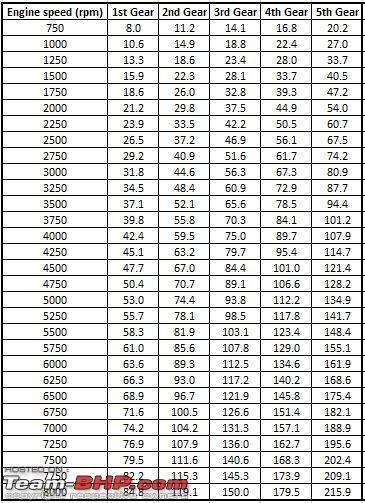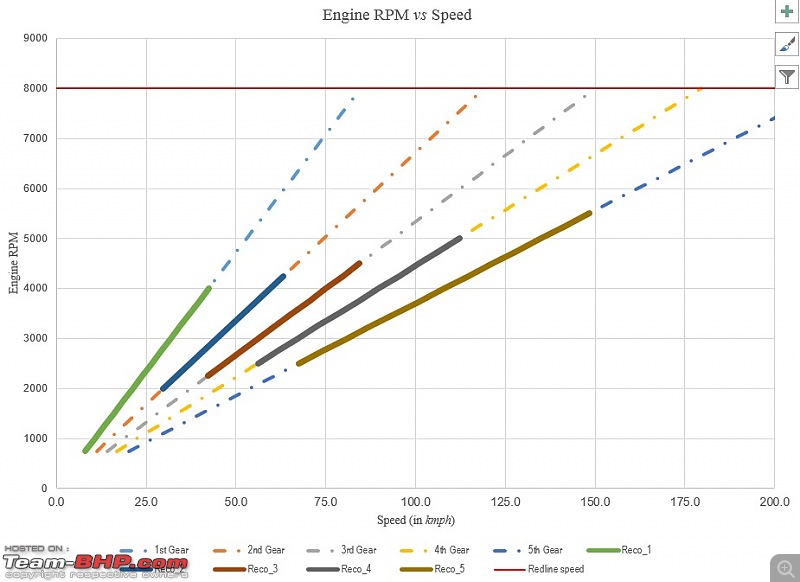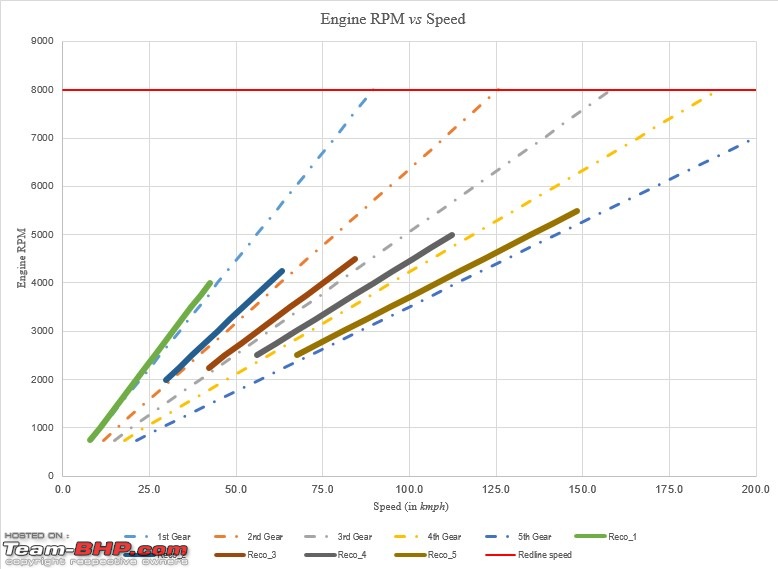So recently I got a Triumph Bonneville and after what are easily my best 4000 kms, I still end up trying to change a gear up even when in 5th (yes, its 5 gears as against 6 for most bikes in that price range).
Since they have made bikes for over 100 years now Triumph should know their motorcycles better than any of us here. This made me think why would they give only 5 gears for such an exceptional bike? During one of the many times I have tried to upshift from 5th, I thought I’ll figure out why. And if you are going to get bored with more than a few paragraphs of my observations and calculations, I’ll tell you here that 5 are probably enough. They were right in Hinckley. Why? Read on.
I went back to what I had read while studying automotive engineering, a little less than 10 years ago – the acceleration diagram. In its basic form, it has vehicle speed on X axis and engine rpm on Y. Two horizontal lines can be marked – one representing the idle rpm and the other, redline. For the Bonneville, this could be around 800 rpm and 8000 rpm. Give or take a few hundred – it doesn’t matter so much.
I didn’t know how to plot linear vehicle speeds in each gear – we can refer the tachometer and speedometer together, but the stock Bonnie doesn’t come with a rev counter. Sorry. You have to buy one for the A3 model and it doesn't come cheap.
So more theoretical calculations then. What you’ll need is number of teeth on every gear and sprockets (front and rear) and then the wheel diameter plus tire specs.
I referred the owners’ manual for gear details. They are available online.
1st - 2.73:1 (41/15)
2nd - 1.95:1 (37/19)
3rd - 1.55:1 (34/22)
4th - 1.29:1 (31/24)
5th - 1.07:1 (29/27)
For the wheel diameter, I took dynamic rolling radius and there are online calculators available for this. This is done to estimate how much the tire expands due to centrifugal rotating force. For the 17 inch rear wheel, I got a ~ 64 cm dynamic rolling diameter which translates to a 201 cm circumference. This means, the rear wheel travels 201 cm in 1 rotation while moving. A friend helped with getting the graph looking the way I wanted it to look like and this is what came out.


The table is plotted on the graph. So for example, if I were to rev out in 1st gear all the way up to redline, I’d reach 75 kmph. That is fairly correct. For those who have Bonnevilles, the proof is in the 5th gear. 80 kmph comes at 3000 rpm fairly accurately and 100 kmph comes at 3750 rpm. You have another 2500 rpms left with a 5th gear and roughly the same torque. So the bonnie doesn’t hesitate to pull from 100 to 140 the same way it did from 60 to 100. Quite nice actually.
I also plotted solid lines called “reco” – meaning recommended speeds in each gear. The key to riding this bike is to shift at 4000 rpm and you are back in the peak torque range for the next gear. Also note the slope of the lines for each gear. 5th has a gentle slope and 1st has a steep slope. Meaning that the bike accelerates faster in 1st gear than 5th. You’ll say oh, I knew that! But understanding this and the graphical representation of the phenomenon is what I wanted to show here.
Now, coming to adding a 6th gear.
The 5th is almost top gear (1:1 reduction ratio) with 1.07:1. 160 kmph (100 mph) is coming at 6000 rpm and beyond this speed, we are risking too much on Indian roads on a non ABS, non-faired bike with unimpressive headlamps.
I assumed 6th to be 0.93:1 (26 / 28 teeth). The 5th gear is having 15% more reduction in this case. So I would say, you could cruise at 100 kmph at slightly above 3000 rpm on the bike theoretically having a 6th gear. But given the linearity of torque, I would say that the bike is making 15% less power in this gear than 5th (power = 2*pi*rps*Torque) Will that be enough or will the engine lug? I think it should be okay for 100 kmph, but wind resistance increases with the square of the vehicle speed. So it will not be enough at say 150-160 kmph. So you might hit an imaginary wall before the engine peaks out owing to insufficient torque multiplication by the gearbox. This wall is reported to come at (an indicated) 180 kmph by some riders on the 5th gear. I would say, realistically this will be near 170. I have no experience riding the bike this fast, but am okay taking the word of people.
What you might end up having is a bike with higher top speed in 5th gear than 6th. You can argue that adding one tooth to make the reduction 27/28 might do the trick. It might, but isn’t worth the gains probably.
I have not done the math on this, but I can probably do it.
What’s a workable solution then on this? I would have to say sprocketing. I don’t usually like to fiddle around the stock setup of a bike, but my experience is limited to bikes with less power and therefore a small region of compromise where everything works well on the bike. With the Bonneville, this peak performance region is abundant. So the risk is fairly low.
Currently, the front sprocket has 18 teeth and rear has 43. Going 19 teeth on the front and 41 teeth on the rear would give some sizeable gains here (about 11%). Individually, these are 5.5% front and 4.8% rear. So speeds at which the bike was running at 5000 rpm, it will now do 4500 rpm. This is a good potential gain on fuel economy and comfort. Yes, acceleration will be compromised, but it has enough oomph anyway. To me, an ideal setup seems to be one with 19 tooth front sprocket. So I went ahead and plotted the lines. Dotted lines are for the 19 teeth sprocket. Solid lines are reference for the 18t front. I might go ahead and get that 19 teeth sprocket and post my feedback here. There are some Bonneville owners who've done this. Would like your inputs too.

 (14)
Thanks
(14)
Thanks
 (2)
Thanks
(2)
Thanks
 (5)
Thanks
(5)
Thanks
 (2)
Thanks
(2)
Thanks
 (1)
Thanks
(1)
Thanks









